Abstract
The type VI variant of the Ehlers-Danlos syndrome (EDS) is a recessively inherited connective-tissue disorder. The characteristic features of the variant are muscular hypotonia, kyphoscoliosis, ocular manifestations, joint hypermobility, skin fragility and hyperextensibility, and other signs of connective-tissue involvement. The biochemical defect in most but not all patients is a deficiency in lysyl hydroxylase activity. Lysyl hydroxylase is an enzyme that catalyzes the formation of hydroxylysine in collagens and other proteins with collagen-like amino acid sequences. We have recently reported an apparently homozygous large-duplication rearrangement in the gene for lysyl hydroxylase, leading to the type VI variant of EDS in two siblings. We now report an identical, apparently homozygous large duplication in an unrelated 49-year-old female originally analyzed by Sussman et al. Our simple-sequence-repeat-polymorphism analysis does not support uniparental isodisomy inheritance for either of the two duplications. Furthermore, we indicate in this study that the duplication in the lysyl hydroxylase gene is caused by an Alu-Alu recombination in both families. Cloning of the junction fragment of the duplication has allowed synthesis of appropriate primers for rapid screening for this rearrangement in other families with the type VI variant of EDS.
Full text
PDF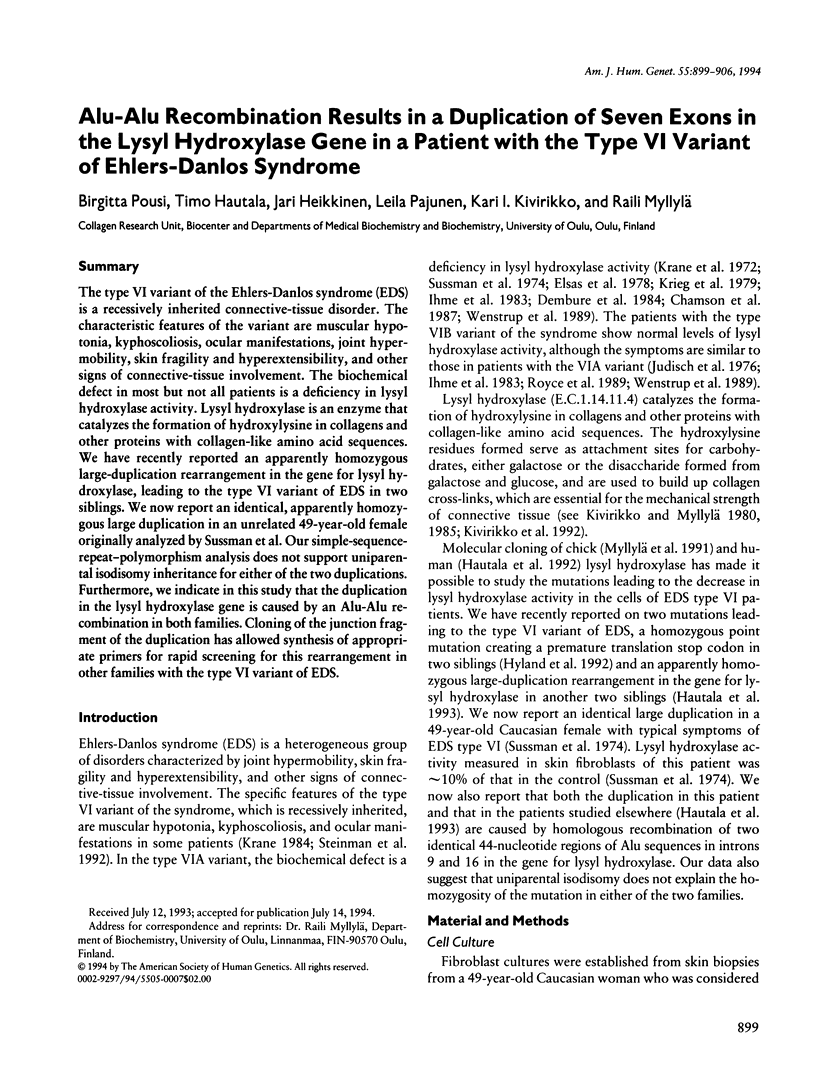
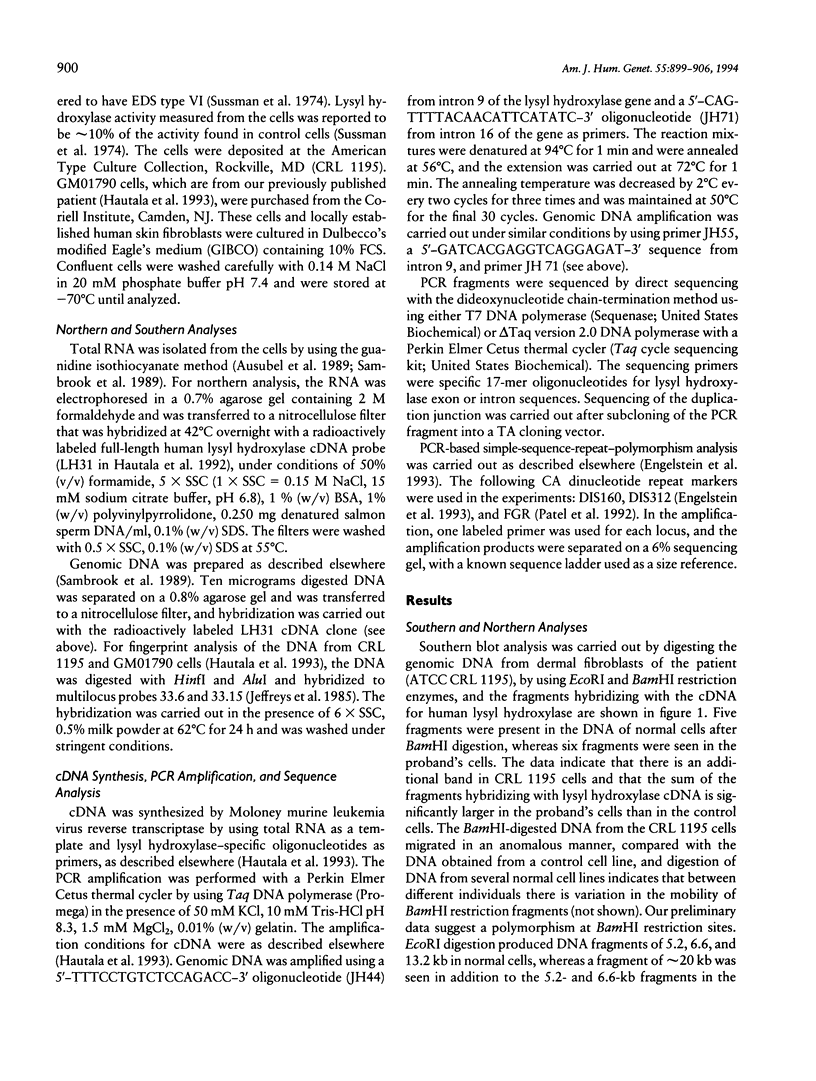
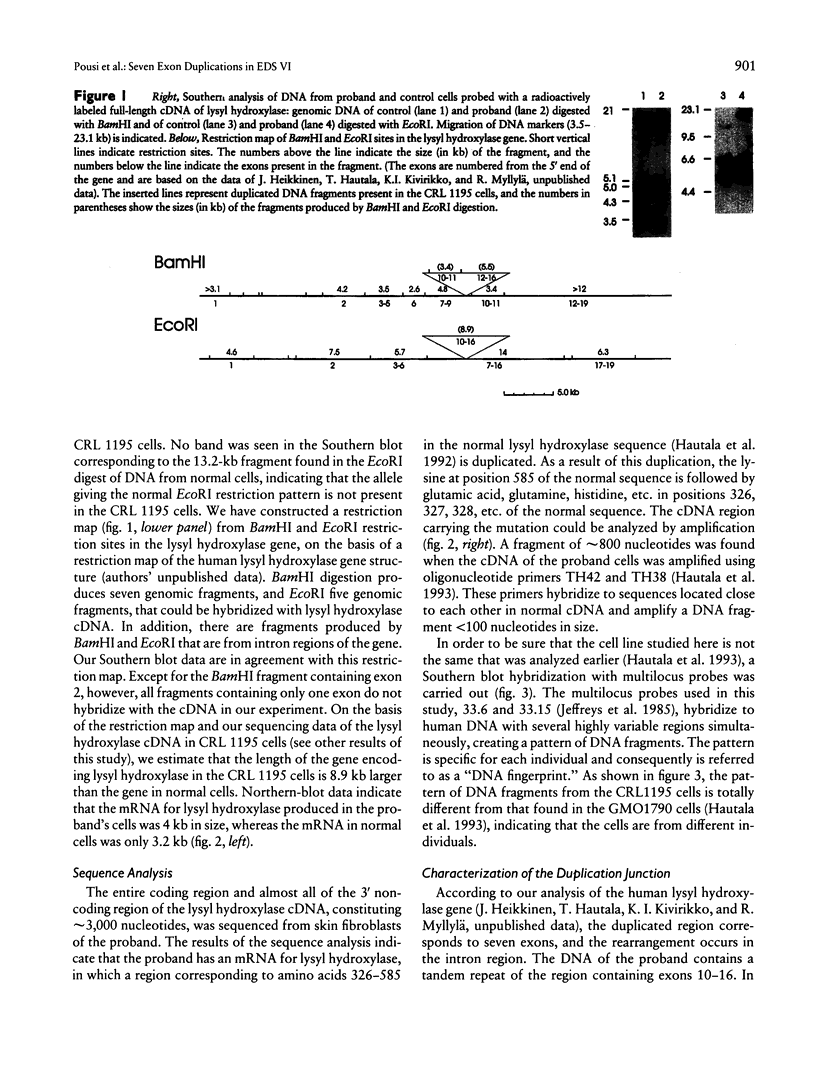
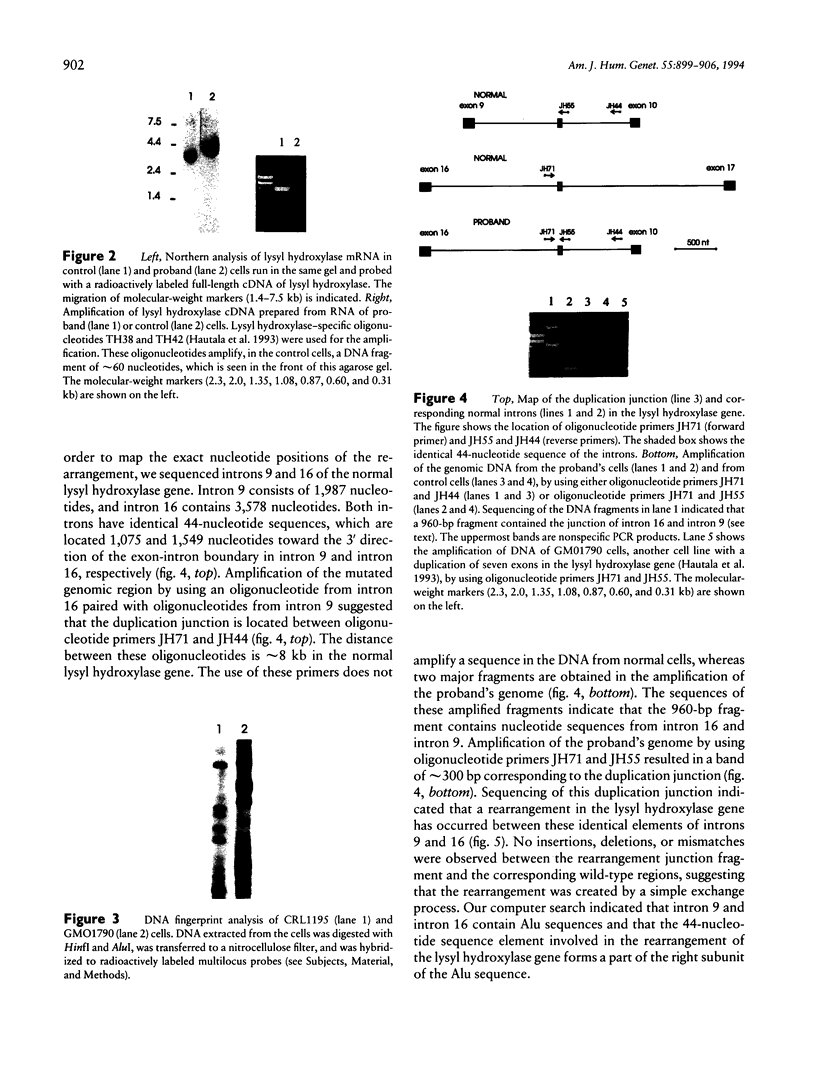
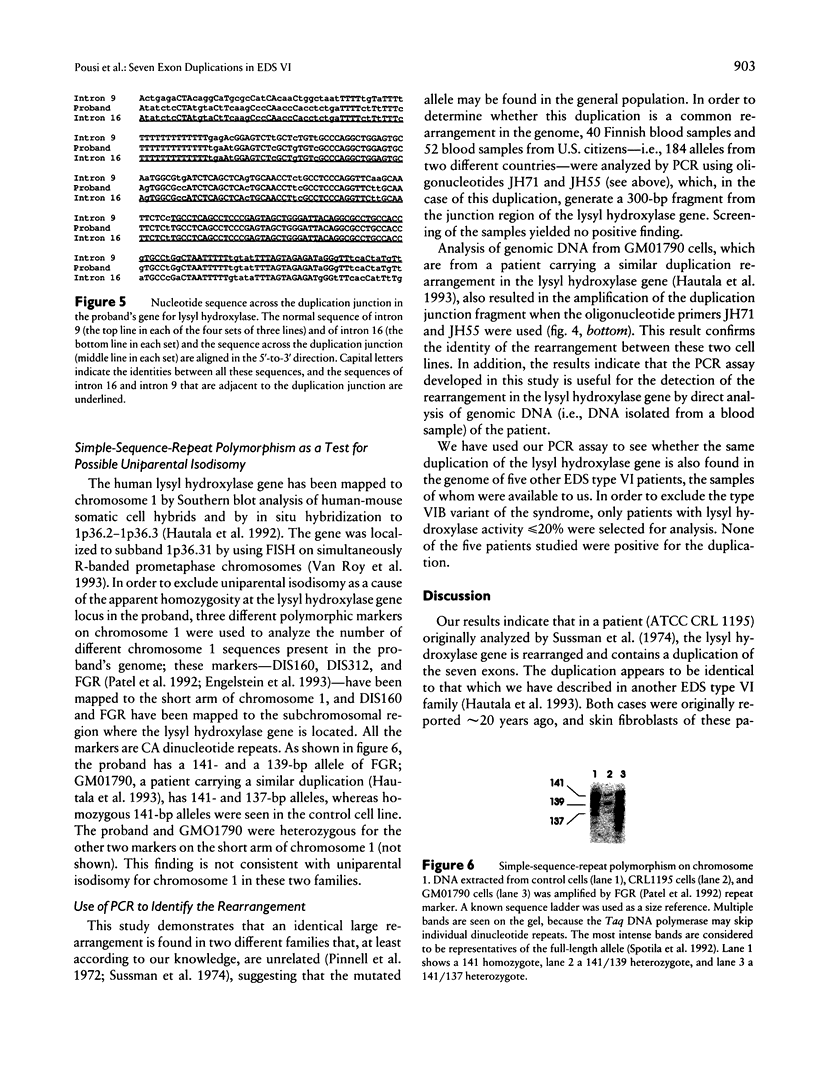
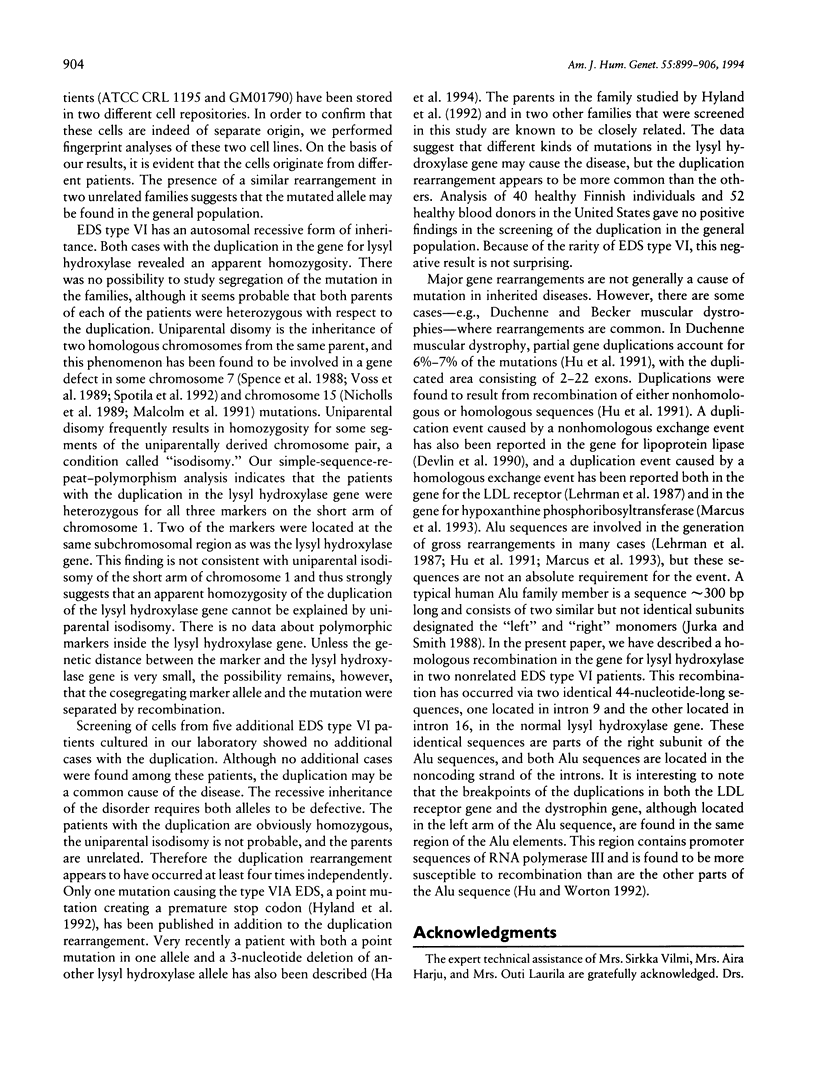
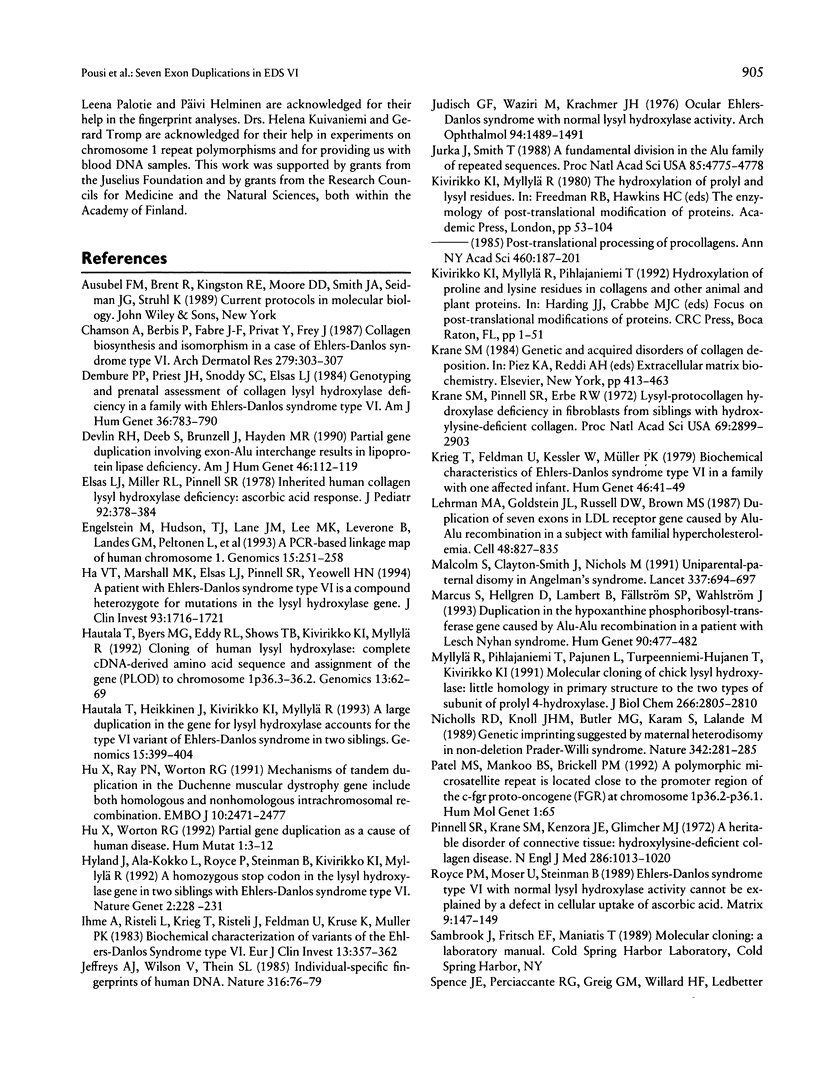
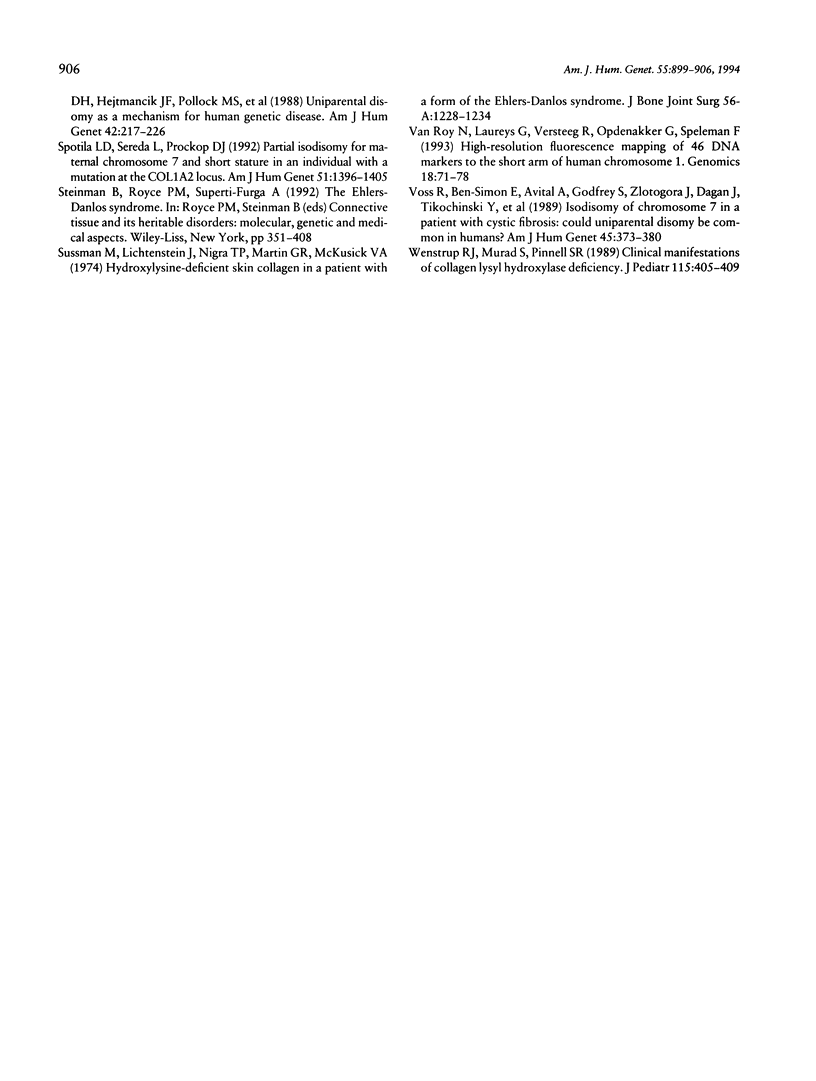
Images in this article
Selected References
These references are in PubMed. This may not be the complete list of references from this article.
- Dembure P. P., Priest J. H., Snoddy S. C., Elsas L. J. Genotyping and prenatal assessment of collagen lysyl hydroxylase deficiency in a family with Ehlers-Danlos syndrome type VI. Am J Hum Genet. 1984 Jul;36(4):783–790. [PMC free article] [PubMed] [Google Scholar]
- Devlin R. H., Deeb S., Brunzell J., Hayden M. R. Partial gene duplication involving exon-Alu interchange results in lipoprotein lipase deficiency. Am J Hum Genet. 1990 Jan;46(1):112–119. [PMC free article] [PubMed] [Google Scholar]
- Elsas L. J., 2nd, Miller R. L., Pinnell S. R. Inherited human collagen lysyl hydroxylase deficiency: ascorbic acid response. J Pediatr. 1978 Mar;92(3):378–384. doi: 10.1016/s0022-3476(78)80423-5. [DOI] [PubMed] [Google Scholar]
- Engelstein M., Hudson T. J., Lane J. M., Lee M. K., Leverone B., Landes G. M., Peltonen L., Weber J. L., Dracopoli N. C. A PCR-based linkage map of human chromosome 1. Genomics. 1993 Feb;15(2):251–258. doi: 10.1006/geno.1993.1054. [DOI] [PubMed] [Google Scholar]
- Ha V. T., Marshall M. K., Elsas L. J., Pinnell S. R., Yeowell H. N. A patient with Ehlers-Danlos syndrome type VI is a compound heterozygote for mutations in the lysyl hydroxylase gene. J Clin Invest. 1994 Apr;93(4):1716–1721. doi: 10.1172/JCI117155. [DOI] [PMC free article] [PubMed] [Google Scholar]
- Hautala T., Byers M. G., Eddy R. L., Shows T. B., Kivirikko K. I., Myllylä R. Cloning of human lysyl hydroxylase: complete cDNA-derived amino acid sequence and assignment of the gene (PLOD) to chromosome 1p36.3----p36.2. Genomics. 1992 May;13(1):62–69. doi: 10.1016/0888-7543(92)90202-4. [DOI] [PubMed] [Google Scholar]
- Hautala T., Heikkinen J., Kivirikko K. I., Myllylä R. A large duplication in the gene for lysyl hydroxylase accounts for the type VI variant of Ehlers-Danlos syndrome in two siblings. Genomics. 1993 Feb;15(2):399–404. doi: 10.1006/geno.1993.1074. [DOI] [PubMed] [Google Scholar]
- Hu X. Y., Ray P. N., Worton R. G. Mechanisms of tandem duplication in the Duchenne muscular dystrophy gene include both homologous and nonhomologous intrachromosomal recombination. EMBO J. 1991 Sep;10(9):2471–2477. doi: 10.1002/j.1460-2075.1991.tb07786.x. [DOI] [PMC free article] [PubMed] [Google Scholar]
- Hu X., Worton R. G. Partial gene duplication as a cause of human disease. Hum Mutat. 1992;1(1):3–12. doi: 10.1002/humu.1380010103. [DOI] [PubMed] [Google Scholar]
- Hyland J., Ala-Kokko L., Royce P., Steinmann B., Kivirikko K. I., Myllylä R. A homozygous stop codon in the lysyl hydroxylase gene in two siblings with Ehlers-Danlos syndrome type VI. Nat Genet. 1992 Nov;2(3):228–231. doi: 10.1038/ng1192-228. [DOI] [PubMed] [Google Scholar]
- Ihme A., Risteli L., Krieg T., Risteli J., Feldmann U., Kruse K., Müller P. K. Biochemical characterization of variants of the Ehlers-Danlos syndrome type VI. Eur J Clin Invest. 1983 Aug;13(4):357–362. doi: 10.1111/j.1365-2362.1983.tb00113.x. [DOI] [PubMed] [Google Scholar]
- Jeffreys A. J., Wilson V., Thein S. L. Individual-specific 'fingerprints' of human DNA. Nature. 1985 Jul 4;316(6023):76–79. doi: 10.1038/316076a0. [DOI] [PubMed] [Google Scholar]
- Judisch G. F., Waziri M., Krachmer J. H. Ocular Ehlers-Danlos syndrome with normal lysyl hydroxylase activity. Arch Ophthalmol. 1976 Sep;94(9):1489–1491. doi: 10.1001/archopht.1976.03910040323006. [DOI] [PubMed] [Google Scholar]
- Jurka J., Smith T. A fundamental division in the Alu family of repeated sequences. Proc Natl Acad Sci U S A. 1988 Jul;85(13):4775–4778. doi: 10.1073/pnas.85.13.4775. [DOI] [PMC free article] [PubMed] [Google Scholar]
- Krane S. M., Pinnell S. R., Erbe R. W. Lysyl-protocollagen hydroxylase deficiency in fibroblasts from siblings with hydroxylysine-deficient collagen. Proc Natl Acad Sci U S A. 1972 Oct;69(10):2899–2903. doi: 10.1073/pnas.69.10.2899. [DOI] [PMC free article] [PubMed] [Google Scholar]
- Krieg T., Feldmann U., Kessler W., Müller P. K. Biochemical characteristics of Ehlers-Danlos syndrome type VI in a family with one affected infant. Hum Genet. 1979 Jan 19;46(1):41–49. doi: 10.1007/BF00278900. [DOI] [PubMed] [Google Scholar]
- Lehrman M. A., Goldstein J. L., Russell D. W., Brown M. S. Duplication of seven exons in LDL receptor gene caused by Alu-Alu recombination in a subject with familial hypercholesterolemia. Cell. 1987 Mar 13;48(5):827–835. doi: 10.1016/0092-8674(87)90079-1. [DOI] [PubMed] [Google Scholar]
- Malcolm S., Clayton-Smith J., Nichols M., Robb S., Webb T., Armour J. A., Jeffreys A. J., Pembrey M. E. Uniparental paternal disomy in Angelman's syndrome. Lancet. 1991 Mar 23;337(8743):694–697. doi: 10.1016/0140-6736(91)90278-w. [DOI] [PubMed] [Google Scholar]
- Marcus S., Hellgren D., Lambert B., Fällström S. P., Wahlström J. Duplication in the hypoxanthine phosphoribosyl-transferase gene caused by Alu-Alu recombination in a patient with Lesch Nyhan syndrome. Hum Genet. 1993 Jan;90(5):477–482. doi: 10.1007/BF00217444. [DOI] [PubMed] [Google Scholar]
- Myllylä R., Pihlajaniemi T., Pajunen L., Turpeenniemi-Hujanen T., Kivirikko K. I. Molecular cloning of chick lysyl hydroxylase. Little homology in primary structure to the two types of subunit of prolyl 4-hydroxylase. J Biol Chem. 1991 Feb 15;266(5):2805–2810. [PubMed] [Google Scholar]
- Nicholls R. D., Knoll J. H., Butler M. G., Karam S., Lalande M. Genetic imprinting suggested by maternal heterodisomy in nondeletion Prader-Willi syndrome. Nature. 1989 Nov 16;342(6247):281–285. doi: 10.1038/342281a0. [DOI] [PMC free article] [PubMed] [Google Scholar]
- Patel M. S., Mankoo B. S., Brickell P. M. A polymorphic microsatellite repeat is located close to the promoter region of the c-fgr proto-oncogene (FGR) at chromosome 1p36.2-p36.1. Hum Mol Genet. 1992 Apr;1(1):65–65. doi: 10.1093/hmg/1.1.65-a. [DOI] [PubMed] [Google Scholar]
- Pinnell S. R., Krane S. M., Kenzora J. E., Glimcher M. J. A heritable disorder of connective tissue. Hydroxylysine-deficient collagen disease. N Engl J Med. 1972 May 11;286(19):1013–1020. doi: 10.1056/NEJM197205112861901. [DOI] [PubMed] [Google Scholar]
- Royce P. M., Moser U., Steinmann B. Ehlers-Danlos syndrome type VI with normal lysyl hydroxylase activity cannot be explained by a defect in cellular uptake of ascorbic acid. Matrix. 1989 Mar;9(2):147–149. doi: 10.1016/s0934-8832(89)80033-2. [DOI] [PubMed] [Google Scholar]
- Spence J. E., Perciaccante R. G., Greig G. M., Willard H. F., Ledbetter D. H., Hejtmancik J. F., Pollack M. S., O'Brien W. E., Beaudet A. L. Uniparental disomy as a mechanism for human genetic disease. Am J Hum Genet. 1988 Feb;42(2):217–226. [PMC free article] [PubMed] [Google Scholar]
- Spotila L. D., Sereda L., Prockop D. J. Partial isodisomy for maternal chromosome 7 and short stature in an individual with a mutation at the COL1A2 locus. Am J Hum Genet. 1992 Dec;51(6):1396–1405. [PMC free article] [PubMed] [Google Scholar]
- Sussman M., Lichtenstein J. R., Nigra T. P., Martin G. R., McKusick V. A. Hydroxylysine-deficient skin collagen in a patient with a form of the Ehlers-Danlos syndrome. J Bone Joint Surg Am. 1974 Sep;56(6):1228–1234. [PubMed] [Google Scholar]
- Van Roy N., Laureys G., Versteeg R., Opdenakker G., Speleman F. High-resolution fluorescence mapping of 46 DNA markers to the short arm of human chromosome 1. Genomics. 1993 Oct;18(1):71–78. doi: 10.1006/geno.1993.1427. [DOI] [PubMed] [Google Scholar]
- Voss R., Ben-Simon E., Avital A., Godfrey S., Zlotogora J., Dagan J., Tikochinski Y., Hillel J. Isodisomy of chromosome 7 in a patient with cystic fibrosis: could uniparental disomy be common in humans? Am J Hum Genet. 1989 Sep;45(3):373–380. [PMC free article] [PubMed] [Google Scholar]
- Wenstrup R. J., Murad S., Pinnell S. R. Ehlers-Danlos syndrome type VI: clinical manifestations of collagen lysyl hydroxylase deficiency. J Pediatr. 1989 Sep;115(3):405–409. doi: 10.1016/s0022-3476(89)80839-x. [DOI] [PubMed] [Google Scholar]







